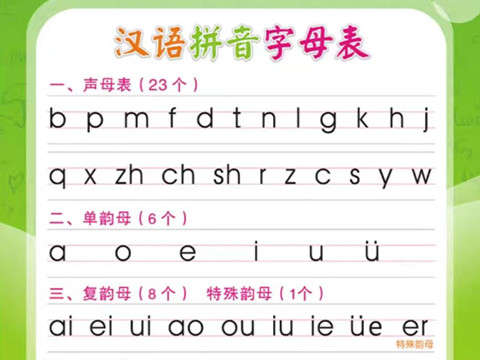链接复制成功!现在分享给好友吧。
Chinese Pinyin, or Mandarin Alphabet, Final 韵母 (yùn mǔ) is a Chinese phonological term that is an integral part of Chinese characters other than the initial consonant and tone. We often refer to this as the rhyme. The final is composed of three parts: the beginning (intermediate), the end (main vowel), and the end. The final structure can be divided into the single final, compound final, and nasal final.
When we first start to read, we often begin with Pinyin. If we learn Pinyin well, then we will already have a strong foundation for reading and writing the Mandarin alphabet is the basis of literacy. It is the bases of reading and writing. It is the first key for pupils to open the door to knowledge. In order to make children better adapt to primary school study, Today, I’d like to share with you the spelling and writing rules of Chinese Pinyin, which is very practical!

Chinese phonetic alphabet: a, o, e, I, u, ü, ai, ei, ui, ao, ou, iu, ie, üe, er, an, en, in, un, ün, ang, eng, ing, ong.
Classification of Chinese Pinyin finals (based on the textbook of Chinese Pinyin in Chinese in primary schools);
(1) Single finals: A, O, E, I, U, ü;
(2) Compound vowels: ai, ei, ui, ao, ou, iu, ie, üe;
(3) Special final: er;
(4) Nasal finals: an, en, in, un, ün, ang, eng, ing, ong;
A. the front nasal finals: an, en, in, un, ün;
B. Posterior nasal finals: ang, eng, ing, ong.
There are 24 vowels in Chinese Pinyin (Mandarin alphabet) in Chinese for primary schools, including 6 single vowels, 8 compound vowels, 1 special vowel, and 9 nasal vowels (5 front nasal vowels and 4 back nasal vowels).
As a tool to assist the pronunciation of Chinese characters, let me give you some tips. Chinese Pinyin is composed of Roman letters. Children and primary school students have some difficulties in learning Chinese Pinyin. Many children and primary school students often forget or become dejected when they learn Pinyin. . However, Chinese Pinyin learning is the basis of Chinese. The specific learning methods should be designed according to the psychological characteristics and actual situation of children and primary school students.
It’s very important to learn Chinese Pinyin well. Chinese Pinyin is the first step to becoming a fluent speaker. It’s also the key to building your Chinese foundation. If you don’t learn Chinese well, it will directly affect the learning progression. It may even greatly affect the pronunciation of Putonghua. Therefore, we should pay attention to the mastery and importance of Pinyin, Don’t think that Pinyin is very basic, just think it’s simple and don’t pay attention to it. It’s because of the foundation that it’s more important. If you don’t master the foundation wall, it will affect your study of Chinese.
To learn Pinyin, we should read more, write more, read more and practice more. By doing this, you can skillfully hold and use Chinese Pinyin.
In fact, pinyin learning is not only a language course but also requires students to adopt a specific learning perspective. That is Because initials and finals are spelled together to form the pronunciation of a word, which is no longer a single sound. Consequently, many students find it difficult to accept such pronunciation at first. However, pinyin learning requires specific methods and skills. That is why there’s a specific approach to mastering the correct pronunciation skills and memory methods. Then students will also find it not so difficult to learn Pinyin.
In order to help children and primary school students master Chinese Pinyin and learn Chinese better, 52ChineseLearning will share more Chinese Pinyin learning resources to help children and primary school students learn Mandarin Alphabet.
Your first 1-on-1 Chinese lesson offer